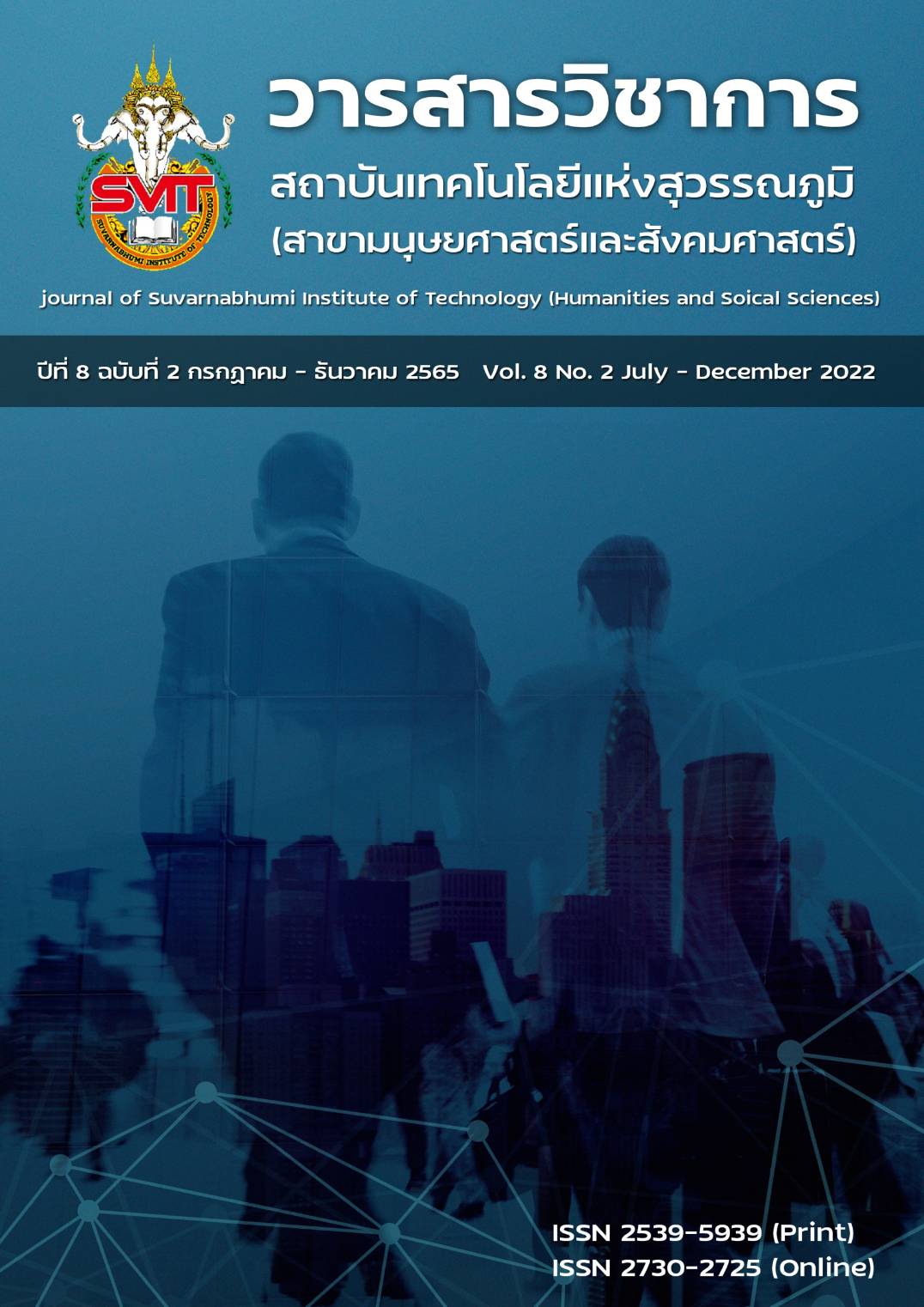EFFICIENCY OF HUMAN RESOURCE MANAGEMENT FOR THE QUALITY OF ORGANIZATIONAL COMMUNICATION, AND ENGAGEMENT OF LIFE INSURANCE AGENTS
Keywords:
Human resource management, Organizational communication, Engagement, Life insurance agentsAbstract
The objectives of this study were 1) to study the key components of efficiency of human resource management, quality of organizational communication, and engagement of life insurance agents, and 2) to study the efficiency model of human resource management for the quality of organizational communication, and engagement of life insurance agents. The data were collected with convenience sampling from 450 life insurance agents in Bangkok and its vicinity, who have worked for at least 3 years. The statistics used to analyze the data were percentage, mean, standard deviation, confirmatory factor analysis and path analysis with structural equation modelling. The results of this study reveal that the most important factor for engagement of life insurance agents was their pride to be a part of the organization. The most important factor for quality of organizational communication was the integration of communication in the organization. The most important factor for the efficiency of human resource management was task assignment for optimization. In addition, engagement of life insurance agent model was collectively and significantly influenced by the efficiency of human resource management (TE=0.85) and quality of organizational communication (TE=-0.65) with the predictive power of 87.40%, while quality of organizational communication was significantly influenced by the efficiency of human resource management (TE=0.49) with the predictive power of 67.70%.
References
ดาวรุ่งรตา วงษ์ไกร. (2563).การบริหารจัดการองค์การที่มีผลต่อคุณภาพชีวิตการทำงานตามมาตรการเฝ้าระวังป้องกันและควบคุมการแพร่ระบาดโรคไวรัสโคโรนา 2019 (COVID-19) ของบุคลากร สำนักงานหลักประกันสุขภาพสาขาเขตพื้นที่ 13 กรุงเทพมหานคร. วารสารวิทยาการจัดการ มหาวิทยาลัยราชภัฎนครปฐม, 7(2), 257–269. https://doi.org/10.14456/jmsnpru.2020.44
วิศิษฐ์ ฤทธิบุญไชย สุรเสกข์ พงษ์หาญยุทธ และแก้วตา ผู้พัฒนพงศ์. (2559).กลยุทธ์ทางการตลาดและการจัดการลูกค้าสัมพันธ์ที่ส่งผลต่อการยอมรับบริษัทประกันชีวิตของคนกรุงเทพมหานคร.วารสารวิจัยสหวิทยาการไทย, 11(5), 16-23.
Ahrari, S., Roslan, S., Zaremohzzabieh, Z., Mohd Rasdi, R., & Abu Samah, A. (2021). Relationship between teacher empowerment and job satisfaction: A Meta-Analytic path analysis. Cogent Education, 8(1), 1898737.
Aldoghan, M. (2021). To Examine the Mediating Impact of Work Engagement Among the Relationship of Human Resource Management Practices and Service Recovery Performance During Pandemic-19. International Journal of eBusiness and
eGovernment Studies, 13(1), 23-49.
Anwar, G., & Abdullah, N. N. (2021). The impact of Human resource management practice on Organizational performance. International journal of Engineering, Business and Management, 5(1), 35-47.
Barros-Arrieta, D., & García-Cali, E. (2021). Internal branding: conceptualization from a literature review and opportunities for future research. Journal of Brand Management, 28(2), 133-151.
Benn, S., Teo, S. T., & Martin, A. (2015). Employee participation and engagement in working for the environment. Personnel Review. 44(4).492-510 https://doi.org/10.1108/PR-10-2013-0179
Byars, L.L. and Rue, L.W. (2008). Human resource management (10th ed.). New York: McGraw-Hill.
Cheney, G., Christensen, L. T., Zorn, T. E., & Ganesh, S. (2010). Organizational communication in an age of globalization: Issues, reflections, practices (2nd ed.). IL: Waveland Press.
Feldner, S. B., & D’Urso, S. (2010). Threads of intersection and division: Joining an ongoing conversation within organizational communication research. Communication Research Trends, 29(1), 4-28.
Ganjoo, K., & Kazi, R. (2018). Internal Branding in the Services Sector: A Conceptual Framework. Global Business & Management Research, 10(4).37-50.
Goodman, M.B. & Hirsch, P.B. (2010). Corporate Communication., New York: Peter Lang.
Hair, J. F., Black, W. C., Babin, B. J., & Anderson, R. E., (2010). Multivariate data analysis: A global perspective. Upper Saddle River, NJ: Pearson Education, International.
Hodgetts, R.M. & Hegar, K.W. (2005). Modern Human Relations at work (9th ed). South-Western, USA: Thomson.
Lee,Y.K., Kim, S. & Kim, S.Y. (2013). The impact of internal branding on employee engagement and outcome variables in the hotel industry. Asia Pacific Journal of Tourism Research, 19(12),1359 –1380.
Magrizos, S., & Roumpi, D. (2020). Doing the right thing or doing things right? The role of ethics of care and ethics of justice in human resource management of social enterprises. Strategic Change, 29(4), 485-496.
Markos, S., & Gossaye, B. (2021). The effect of internal communication on employee engagement: Empirical evidence from commercial Bank of Ethiopia. International Journal of Information, Business and Management, 13(2), 47-71.
Mazzei, A. (2014). Internal communication for employee enablement: Strategies in American and Italian companies. Corporate Communications An International Journal, 19 (1). 82-95.
Rittiboonchai, W., Pinyokul, K., Na-Nakorn, N., & Jermsittiparsert, K. (2021). The moderating effect of information technology capability on the relationship of management components and firm performance of chemical industry. Journal of management information and decision sciences, 24(4), 1-14.
Robertson-Smith, G. & Markwick, C. (2009). Employee Engagement A review of current thinking. Report 469. Brighton UK: Institute for Employment Studies.
Siriguppi, D., & Nair, J. (2021). TATA AIA Life Leverages Digital Technologies to Create a Superior Customer Experience. IUP Journal of Marketing Management, 20(4), 400-411.
Verghese, A.K., (2017). Internal Communication: Practices and Implications. SCMS Journal of Indian Management, 14 (3) 103-113.
Verčič, A. T. (2021). The impact of employee engagement, organizational support and employer branding on internal communication satisfaction. Public Relations Review, 47(1), 102009.
Vincent, S., Bamber, G. J., Delbridge, R., Doellgast, V.,Grady, J., & Grugulis, I. (2020). Situating human resource management in the political economy: Multilevel the rising and opportunities for kaleidoscopic imagination. Human Resource Management Journal,
(4), 461-477.
Xie, C., Bagozzi, R. P., & Meland, K. V. (2015). The impact of reputation and identity congruence on employer brand attractiveness. Marketing Intelligence & Planning, 33 (2), 124-146.
Downloads
Published
Issue
Section
License
Copyright (c) 2022 Suvarnabhumi Institute of Technology

This work is licensed under a Creative Commons Attribution-NonCommercial-NoDerivatives 4.0 International License.
บทความที่ได้รับการตีพิมพ์เป็นลิขสิทธิ์ของวารสารวิชาการ สถาบันเทคโนโลยีแห่งสุวรรณภูมิ
ข้อความที่ปรากฏในบทความแต่ละเรื่องในวารสารวิชาการเล่มนี้เป็นความคิดเห็นส่วนตัวของผู้เขียนแต่ละท่านไม่เกี่ยวข้องกับสถาบันเทคโนโลยีแห่งสุวรรณภูมิ และคณาจารย์ท่านอื่นๆในสถาบันฯ แต่อย่างใด ความรับผิดชอบองค์ประกอบทั้งหมดของบทความแต่ละเรื่องเป็นของผู้เขียนแต่ละท่าน หากมีความผิดพลาดใดๆ ผู้เขียนแต่ละท่านจะรับผิดชอบบทความของตนเองแต่ผู้เดียว





